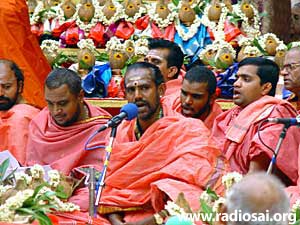 |
 |
 |
Volume
5 - Issue 10
OCTOBER 2007 |
CHAPTER 17 1. Arjuna says, Krishna, I want to ask You a question about the modalities of worship. I have seen two kinds of people, who seem to worship You in two entirely different ways. One group employs elaborate rituals and its members assert that unless these procedures are rigorously followed, God would be displeased with the worship. The other group does not seem to bother at all about procedures. Its members behave in strange ways; they talk to You, sing to You and dance for You. In many ways they appear crazy and abnormal. Yet some people say that that is the way to worship You. I am totally confused. Please can You explain how exactly are You to be worshipped?’
2. Krishna smiles and replies, ‘Arjuna, based on all the things I have told you thus far, you ought to be able to figure out the answer yourself! Yet, since you have asked Me, I shall give the answer.’ 3. ‘There are basically two approaches to worship, the external approach and the internal approach. The external approach relies heavily on procedures while the internal approach does not bother about procedures. Both approaches are acceptable, provided Love is the basis.’ 4. Arjuna says, ‘Krishna, this I am unable to understand. The two approaches appear to be totally contradictory; and yet You say both are acceptable to You! How can that be?” 5. Krishna replies, ‘Oh no, the two approaches are not contradictory. Let me explain with some detailed examples. Let us take one form of ritual. In this, the devotee has an idol, and offers worship to it by chanting various Mantras. Instead of mechanically uttering the Mantras without understanding the meaning, try to understand what is being said and done.’ 6. ‘First you welcome God to your house. You wash His feet at the entrance and respectfully conduct Him inside. After this you offer Him a seat. Next you make preparations so that He can have a bath. After the bath is over, you offer Him new clothes. Then flowers, incense etc. After this the lunch and so on. All this is done via suitable Mantras.’
7. ‘A person who goes through this routine mechanically before the idol would not realise that He is actually having the Lord as his guest. But one who is filled with that feeling does not think he is uttering routine chants. Instead, he is swept by the feeling that he is actually playing host to the Lord. No, it is not make believe as an atheist would imagine. Since I am the Indweller, I know exactly what the devotee feels. If the devotee is merely acting as a chanting machine, then the worship remains external. But if the chants are uttered with feeling, then the very same ritual becomes internal! See?!’ 8. ‘Another example. You know Vedic priests perform complicated rituals called Yajna. These Yajnas are full of grand chants that proclaim the Glory of God. If the Vedic Mantras are uttered with feeling, if the one who chants experiences the Glory of God while chanting, then the Yajna is not a mere Vedic drill but a profound experience; otherwise it is a ritual that sceptics would dismiss as extremely wasteful. But if the Mantras are uttered with deep feeling, then even the atheist would be irresistibly moved by the majesty of the sound and the power of the words.’ 9. ‘In short, if Love is made the basis, then it really does not matter whether the procedure adopted is formal or informal. Have I not told you earlier that as far as I am personally concerned, I am delighted if you worship Me with just a flower, a fruit, a leaf or even just a bit of water.’ 10. ‘I shall go one step further. You don’t have to offer Me a flower. To get that flower you have to go to a shop or a garden. Save yourself all that trouble. Just say, “God, I offer You one bad habit of mine!” God would be quite happy with that!’ 11. Arjuna replies, ‘Krishna, I know you mentioned this before but I still think you can’t be serious.’ 12. With a big laugh Krishna replies, ‘No, that is not true, and as a matter of fact I am quite serious. You see Arjuna, when you offer Me a bad habit, you become purer to that extent and come a bit closer to Me. Is it any wonder that I am pleased?’
13. ‘Arjuna, for Me the priority is faith plus Love. A child is not able to speak properly; it is just able to mutter a few words incoherently. Yet the mother feels deliriously happy. Why? Because the mother sees Love in the child’s words, that is why. She is not bothered about grammar but Love! Got it?’ 14. ‘It is the same with Me, naturally! For Me, Pure Love is primary. If unadorned Love is all that you can offer, no problem! I am not bothered about the frills.’ 15. ‘Let us go back to the mother and child example. Let us say the child has composed a small poem expressing her love to her mother. The mother is very happy, as happy as she was when her daughter was a mere baby and was able to only prattle. What the poem and the prattle have in common is love, and that is what really matters.’ 16. ‘Having said that, I must clarify that I am not anti-procedure. Just that if procedure is what you want to follow, then do so with the proper feeling. It is not correct to worship the idol thinking all the time about other matters. In this case, there is a lack of harmony between thought and action. As you know I am a great stickler for harmony of feeling, thought, word and deed. That ought not to be compromised, ever!’ 17. Arjuna says, ‘Krishna, if ritualistic procedures can make a person slip, how come they came into existence in the first place? What role do they have to play, if at all, in the development of devotion?’ 18. Krishna replies, ‘Now that is an interesting question, and let Me reply to it in some detail. Thousands of years ago, the world was very different. There were many sages and Rishis then, and they all adored Me so much that that they spent all their time thinking of Me and doing My work in many ways.’ 19. ‘For example, the Rishis would meditate intensely for long stretches of time, and it was then that I would reveal great Spiritual Truths to them. Later, these Truths got compiled into what are called the Vedas.’ 20. ‘The Rishis performed a useful service to Society. They ran little schools called Gurukulas, where disciples absorbed Spiritual Truths. This is how the Vedas have been preserved through time, by being passed on from generation to generation. By the way, do you know that I Myself attended a Gurukula?!’
21. ‘Besides preserving Spiritual Knowledge, the Rishis also started the custom of performing Yajnas. As they chanted the Mantras, there was a tremendous outpouring of Love for God, and so compelling was the grandeur of the chant that they drew even ordinary folk to the function. Their very presence did a lot of good to these people, even though they did not understand one single word of the Mantras chanted. So powerful were the vibrations of the Vedic sound that it produced beneficial effects unknown to them.’ 22. ‘In later years, many ordinary people took to rituals, often without understanding their full significance. However, this in itself is not bad. These people performed rituals with full faith – that is the important point. In due course, they began to understand the inner meaning, whereupon the ritual acquired new significance for them.’ 23. ‘You see Arjuna, children are taught multiplication tables. At that age, they do not quite know the significance of the tables. They just get it by heart, because that is what they are supposed to do. Years later, when they understand better the principle underlying arithmetic, these tables become more meaningful.’ 24. ‘In short, rituals are a stepping stone. They are like the floatation aids used by those learning to swim. Once they know how to swim, the floatation aids are thrown away. In the same manner, rituals are supposed to get people started on the path of worship; later, when love for God develops in full measure, rituals could be given up.’ 25. ‘The bottom line is faith and Love. If these are present, then any procedure or ritual, formal or otherwise, is acceptable. That is the point really. Got it?’ (To be continued...)
– Heart2Heart Team |
Vol 5 Issue 10 - OCTOBER 2007
|
Best viewed in Internet Explorer - 1024 x 768 resolution. |




